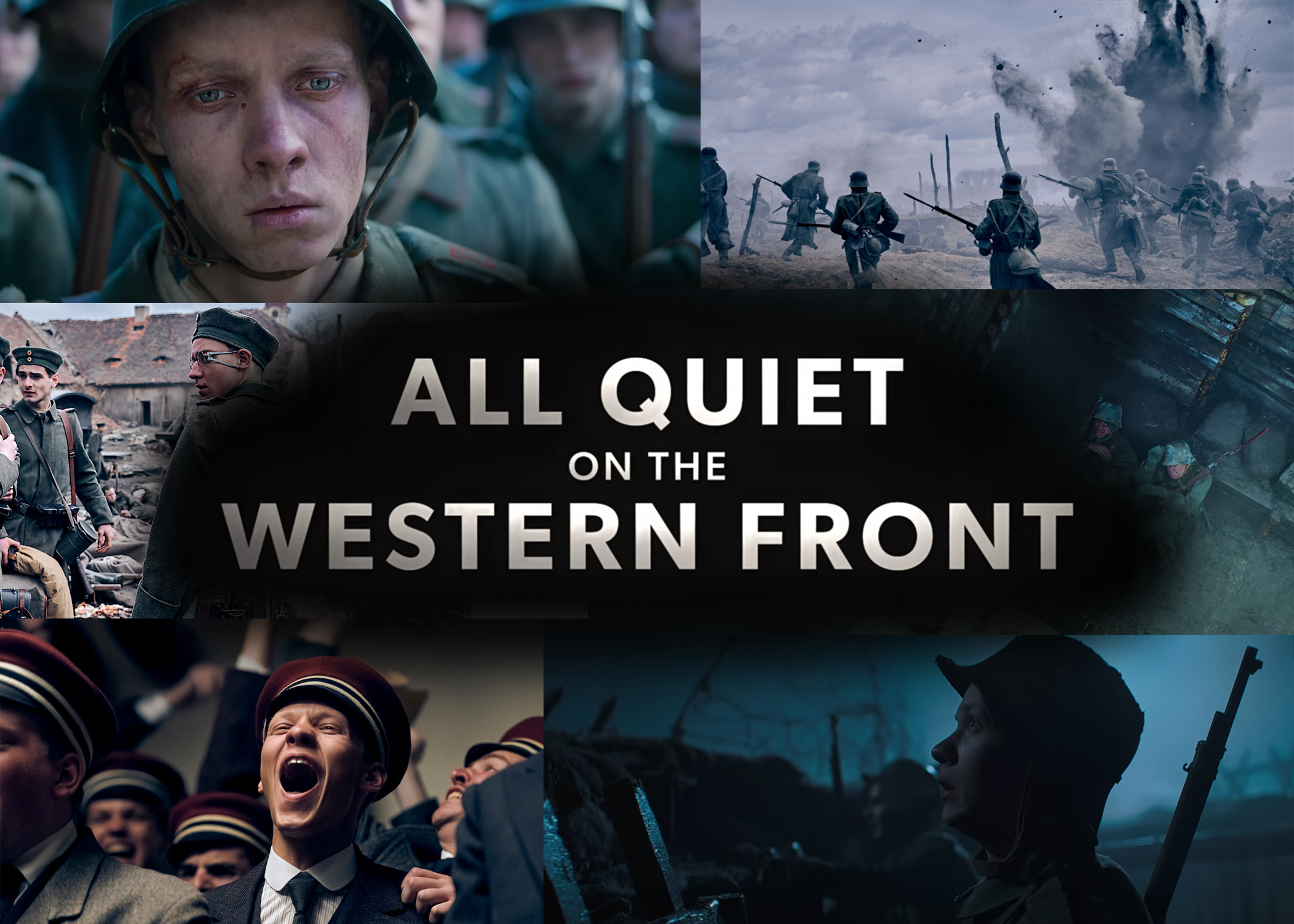Review | ‘All Quiet on the Western Front’ is a visceral achievement
Edward Berger’s ‘All Quiet on the Western Front’ delivers a multi-faceted depiction of the first World War fueled by youthful naiveté, corrupted power and the crumbling of faith. Photo collage by SIMRAH AHMAD, staff photographer
As the film’s young protagonist Paul Bäumer (Felix Kammerer) forges his parent’s signature onto a document declaring him ready to serve outside of the recruitment center of Germany, it takes every ounce of restraint for the audience to not shout “Don’t do it! Don’t go in there!” as if it were a horror film.
However, one could argue that there is no horror scarier than the events that transpired over the course of the next two and a half hours.
Surrounded by misinformation, Paul and his friends are enthusiastic to suit up for the Germans. Motivated by a strong sense of nationalism and dreams of becoming heroes, it doesn’t take long for them to learn their lesson — the same lesson conveyed in Erich Maria Remarque’s 1928 book from which the material is adapted from — that there are no heroes in war.
“All Quiet on the Western Front” is a 2022 German-language film directed by Edward Berger which presents a timeline of a soldier’s journey through World War I — from the day of his recruitment until the last day of the war. It is also the third adaptation of Remarque’s book. The film was screened as part of the Newport Beach Film Festival, which was open to the public.
While other war films are driven by heroics and valor — such as the quest to find Private Ryan in “Saving Private Ryan” or the trek to deliver orders of great significance in “1917” — this film treads more along the lines of Elem Klimov’s 1985 anti-war film “Come and See," which shares a young boy’s excitement to join World War II until he experience Nazi atrocities.
“All Quiet on the Western Front" is only concerned with the dwindling of humanity as soldiers become engrossed in the horrors that await them and the power dynamics responsible for the war.
Our protagonist Paul serves as our eyes throughout the film, but more importantly, he serves as a symbol. We’re given little insight into who Paul is and quite frankly, he could be interchanged with any other young soldier which would have had the same effect.
He’s used to guide us throughout the world and show what many collectively endured. Yet, by the end credits, our affinity for Paul is so strong because he’s one of the few elements we’re able to latch onto.
Much of our emotional connections lie with the supporting cast of characters who each bring their own distinct outlooks on the war, cope with their own individual methods and suffer in unique ways. Whether it be a handkerchief, a matchbox or a movie poster, each holds onto some physical token that can transport them away mentally — all except Paul who relies on those around him to accomplish this.
Berger’s direction and James Friend’s cinematography are nothing short of stunning. They expertly juxtapose the tranquility of nature with the formidable machinery. The way in which the camera navigates the landscape at eye-level is immersive and plants us as one of the members of the German front-lines. The blue, gray and brown color palette is bleak and gritty and allows the jarring sight of bright red blood to draw the eye.
While maybe not to the extent of the opening D-Day scene in “Saving Private Ryan,” many of the battle sequences are extremely visceral and pull back no punches in terms of guts and gore.
Accompanied by a fantastic sound design, each bullet rips through the air and you can hear the pop as metal meets skin and bone. There’s almost always a consistent rumble of guns, bombs and tanks, but Berger is conscious about the power of using silence as well.
One sequence in particular that starts in the trenches and ends in a bomb crater is so emotionally impactful that I watched the surrounding audience members in the movie theater either clench their fists or wipe away tears.
The story occasionally cuts to German diplomat Matthias Erzeberger (Daniel Brühl) who negotiates Germany’s surrender. Sat across from the French diplomats, the tension in these scenes is almost equally as palpable as the battle scenes. Brühl, who appeared in “Rush,” “Inglorious Bastards” and various Marvel projects, is one of the few recognizable faces for American audiences.
Although these scenes may not be as exciting visually, they are a cruel reminder of how the war was prolonged by men more concerned with poetry and legacy than the lives of their soldiers. Berger uses these scenes to employ a motif of food where the generals and diplomats are constantly eating lavish meals and the soldiers are left with stale turnip bread.
With a run-time just under two and a half hours, there wasn’t a single instance where I felt compelled to check the clock or even evaluate where we were at in the story. There are multiple moments that felt as if the movie could have ended right then and there, but Berger decides to push the story further.
The ending he settles on is the right choice. I found it to be an incredible full-circle moment that was equally as beautiful as it was tragic.
In a genre that’s been saturated by masterpieces since the beginning of cinema, Berger’s “All Quiet on the Western Front” is a stunning contribution to the war film canon. The film will be released on Oct. 28 by Netflix. The convenience of pulling the film up on your laptop from the comfort of your own bed may be tempting, but I urge all viewers to find the biggest screen possible for this viewing.


